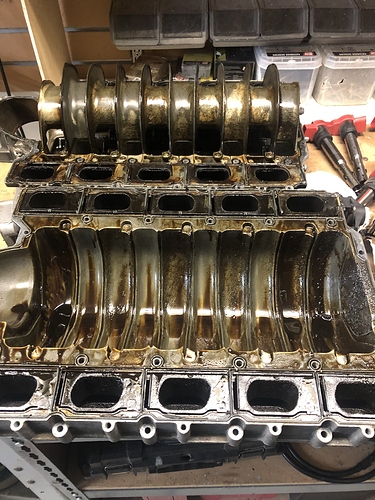My freakin’ brain hurts.
After opening my 200,000 mile never before opened IM I saw this:
I saw a post (and a reply in my engine drop thread) about FCV, so I started researching here and elsewhere, and holy cow what a range of opinions. What I have gleaned so far is:
- They seem to keep the IM’s clean (no major confirmation about carbonization effect)
- You can put them a few different places (before the PCV valve, after and in replacement of) as well as in the turbo loop (V10’s in the S6 don’t have them but wouldn’t that be a hoot!)
- Don’t let the system freeze (which to me meant they were not plumbed well creating too much condensation)
- Catch Can with baffle and filter was preferred, if you are eco responsible at all, don’t vent to air
- If not done correctly, you can damage your engine (pressure builds in case)
- The concept may screw with the natural movement of blow by gases in the crank case which may result in more unwanted contamination
I am sure I have more to learn that may influence the above. As far as pros and cons, some say it’s only worth it on race cars or turbo cars. Some swear by it showing huge amounts of a watery mix with really no oil (which makes me wonder if that’s condensation created by the way the system is plumbed).
Now Justin mentioned that the oil looked unusual and that the oil creep into the spark wells may be indicative of a pressure issue in the top of the engine. I did have to change out my PCV valve a couple of years ago, so the valve may have been in trouble for a while (caught it on state inspection) and if it screwed with the pressure could have forced more oil into places you didn’t want it. The TB’s and plenum looked a little dirty but no real oil in them (which makes sense). So all of this may be the result of the valve causing pressure issues.
At the same time, my feeling is an insulated catch can system placed BEFORE the PCV, retaining the PCV system, might be a good modification, whether or not it helps with carbonization (I think it may help some, but I can’t tell if the valve design in the V10 allows exhaust gasses to build up on the intake valve as part of the piston cycle). I think it should help cut back on the oil that can make it’s way into the IM.
So, what do you think?
- Do they do reduce oil into the IM without messing with pressure?
- Could they be harmful?
- Is the idea of placing one before the PCV and retaining the PCV good?
- Or would it be better to replace my PCV every 5 years or so?
What I really need to know is if the inside of an IM gets oil in it with a fully functioning PCV system, since that will influence whether I try this or not.
I was appalled at the oil there and can only think that the presence of oil would have a detrimental effect on the flap system.
TIA for all responses,
Ed

